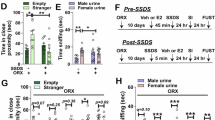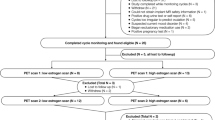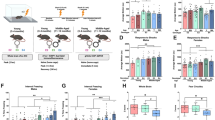Abstract
Post-traumatic stress disorder (PTSD) is twice as common in women as in men; it is a major public health problem whose neurobiological basis is unknown. In preclinical studies using fear conditioning and extinction paradigms, women and female animals with low estrogen levels exhibit impaired extinction retrieval, but the mechanisms that underlie these hormone-based discrepancies have not been identified. There is much evidence that estrogen can modulate dopaminergic transmission, and here we tested the hypothesis that dopamine–estrogen interactions drive extinction processes in females. Intact male and female rats were trained on cued fear conditioning, and received an intraperitoneal injection of a D1 agonist or vehicle before extinction learning. As reported previously, females that underwent extinction during low estrogen estrous phases (estrus/metaestrus/diestrus (EMD)) froze more during extinction retrieval than those that had been in the high-estrogen phase (proestrus; PRO). However, D1 stimulation reversed this relationship, impairing extinction retrieval in PRO and enhancing it in EMD. We also combined retrograde tracing and fluorescent immunohistochemistry to measure c-fos expression in infralimbic (IL) projections to the basolateral area of the amygdala (BLA), a neural pathway known to be critical to extinction retrieval. Again we observed diverging, estrous-dependent effects; SKF treatment induced a positive correlation between freezing and IL-BLA circuit activation in EMD animals, and a negative correlation in PRO animals. These results show for the first time that hormone-dependent extinction deficits can be overcome with non-hormone-based interventions, and suggest a circuit-specific mechanism by which these behavioral effects occur.
Similar content being viewed by others
Log in or create a free account to read this content
Gain free access to this article, as well as selected content from this journal and more on nature.com
or
References
Arnsten AF (2007). Catecholamine and second messenger influences on prefrontal cortical networks of ‘representational knowledge’: a rational bridge between genetics and the symptoms of mental illness. Cereb Cortex 17 (Suppl 1): i6–i15.
Arnsten AFT (2011). Catecholamine influences on dorsolateral prefrontal cortical networks. Biol Psychiatry 69: e89–e99.
Arnsten AFT, Wang MJ, Paspalas CD (2012). Neuromodulation of thought: flexibilities and vulnerabilities in prefrontal cortical network synapses. Neuron 76: 223–239.
Becker JB, Arnold AP, Berkley KJ, Blaustein JD, Eckel LA, Hampson E et al (2005). Strategies and methods for research on sex differences in brain and behavior. Endocrinology 146: 1650–1673.
Breslau N, Chilcoat HD, Kessler RC, Peterson EL, Lucia VC (1999). Vulnerability to assaultive violence: further specification of the sex difference in post-traumatic stress disorder. Psychol Med 29: 813–821.
Burgos-Robles A, Vidal-Gonzalez I, Santini E, Quirk GJ (2007). Consolidation of fear extinction requires NMDA receptor-dependent bursting in the ventromedial prefrontal cortex. Neuron 53: 871–880.
Chang C, Berke JD, Maren S (2010). Single-unit activity in the medial prefrontal cortex during immediate and delayed extinction of fear in rats. PLoS one 5: e11971.
Egan MF, Goldberg TE, Kolachana BS, Callicott JH, Mazzanti CM, Straub RE et al (2001). Effect of COMT Val108/158 Met genotype on frontal lobe function and risk for schizophrenia. Proc Natl Acad Sci USA 98: 6917–6922.
Festa ED, Jenab S, Weiner J, Nazarian A, Niyomchai T, Russo SJ et al (2006). Cocaine-induced sex differences in D1 receptor activation and binding levels after acute cocaine administration. Brain Res Bull 68: 277–284.
Festa ED, Russo SJ, Gazi FM, Niyomchai T, Kemen LM, Lin S-N et al (2004). Sex differences in cocaine-induced behavioral responses, pharmacokinetics, and monoamine levels. Neuropharmacology 46: 672–687.
Frye CA, Sora I (2010). Progesterone reduces hyperactivity of female and male dopamine transporter knockout mice. Behav Brain Res 209: 59–65.
Gabbott PLA, Warner TA, Jays PRL, Salway P, Busby SJ (2005). Prefrontal cortex in the rat: projections to subcortical autonomic, motor, and limbic centers. J Comp Neurol 492: 145–177.
Glover EM, Jovanovic T, Mercer KB, Kerley K, Bradley B, Ressler KJ et al (2012). Estrogen levels are associated with extinction deficits in women with posttraumatic stress disorder. Biol Psychiatry 72: 19–24.
Goldwater DS, Pavlides C, Hunter RG, Bloss EB, Hof PR, McEwen BS et al (2009). Structural and functional alterations to rat medial prefrontal cortex following chronic restraint stress and recovery. Neuroscience 164: 798–808.
Graham BM, Milad MR (2013). Blockade of estrogen by hormonal contraceptives impairs fear extinction in female rats and women. Biol Psychiatry 73: 371–378.
Herry C, Ciocchi S, Senn V, Demmou L, Müller C, Lüthi A (2008). Switching on and off fear by distinct neuronal circuits. Nature 454: 600–606.
Hikind N, Maroun M (2008). Microinfusion of the D1 receptor antagonist, SCH23390 into the IL but not the BLA impairs consolidation of extinction of auditory fear conditioning. Neurobiol Learn Mem 90: 217–222.
Hoffman AN, Armstrong CE, Hanna JJ, Conrad CD (2010). Chronic stress, cyclic 17β-estradiol, and daily handling influences on fear conditioning in the female rat. Neurobiol Learn Mem 94: 422–433.
Hoover WB, Vertes RP (2007). Anatomical analysis of afferent projections to the medial prefrontal cortex in the rat. Brain Struct Funct 212: 149–179.
Huang Y-Y, Simpson E, Kellendonk C, Kandel ER (2004). Genetic evidence for the bidirectional modulation of synaptic plasticity in the prefrontal cortex by D1 receptors. Proc Natl Acad Sci USA 101: 3236–3241.
Hughes KC, Shin LM (2011). Functional neuroimaging studies of post-traumatic stress disorder. Expert Rev Neurotherap 11: 275–285.
Hui IR, Hui GK, Roozendaal B, McGaugh JL, Weinberger NM (2006). Posttraining handling facilitates memory for auditory-cue fear conditioning in rats. Neurobiol Learn Mem 86: 160–163.
Jacobs E, D’Esposito M (2011). Estrogen shapes dopamine-dependent cognitive processes: implications for women’s health. J Neurosci 31: 5286–5293.
Kosten TA, Lee HJ, Kim JJ (2007). Neonatal handling alters learning in adult male and female rats in a task-specific manner. Brain Res 1154: 144–153.
Kritzer MF, Creutz LM (2008). Region and sex differences in constituent dopamine neurons and immunoreactivity for intracellular estrogen and androgen receptors in mesocortical projections in rats. J Neurosci 28: 9525–9535.
Lebron-Milad K, Graham BM, Milad MR (2012). Low estradiol levels: a vulnerability factor for the development of posttraumatic stress disorder. Biol Psychiatry 72: 6–7.
Lebron-Milad K, Milad MR (2012). Sex differences, gonadal hormones and the fear extinction network: implications for anxiety disorders. Biol Mood Anxiety Disord 2: 3.
Llaneza DC, Frye CA (2009). Progestogens and estrogen influence impulsive burying and avoidant freezing behavior of naturally cycling and ovariectomized rats. Pharmacol Biochem Behav 93: 337–342.
Mayerhofer A, Hemmings HC, Snyder GL, Greengard P, Boddien S, Berg U et al (1999). Functional dopamine-1 receptors and DARPP-32 are expressed in human ovary and granulosa luteal cells in vitro. J Clin Endocrinol Metab 84: 257–264.
Milad MR, Igoe SA, Lebron-Milad K, Novales JE (2009). Estrous cycle phase and gonadal hormones influence conditioned fear extinction. Neuroscience 164: 887–895.
Milad MR, Quirk GJ (2002). Neurons in medial prefrontal cortex signal memory for fear extinction. Nature 420: 70–74.
Milad MR, Zeidan MA, Contero A, Pitman RK, Klibanski A, Rauch SL et al (2010). The influence of gonadal hormones on conditioned fear extinction in healthy humans. Neuroscience 168: 652–658.
Paxinos G, Watson C (2005) The rat brain in stereotaxic coordinates. Elsevier Academic Press.
Phelps EA, Delgado MR, Nearing KI, LeDoux JE (2004). Extinction learning in humans: role of the amygdala and vmPFC. Neuron 43: 897–905.
Quirk GJ, Beer JS (2006). Prefrontal involvement in the regulation of emotion: convergence of rat and human studies. Curr Opin Neurobiol 16: 723–727.
Quirk GJ, Mueller D (2008). Neural mechanisms of extinction learning and retrieval. Neuropsychopharmacology 33: 56–72.
Raineki C, De Souza MA, Szawka RE, Lutz ML, De Vasconcellos LFT, Sanvitto GL et al (2009). Neonatal handling and the maternal odor preference in rat pups: involvement of monoamines and cyclic AMP response element-binding protein pathway in the olfactory bulb. Neuroscience 159: 31–38.
Shansky RM, Glavis-Bloom C, Lerman D, McRae P, Benson C, Miller K et al (2004). Estrogen mediates sex differences in stress-induced prefrontal cortex dysfunction. Mol Psychiatry 9: 531–538.
Shansky RM, Hamo C, Hof PR, McEwen BS, Morrison JH (2009). Stress-induced dendritic remodeling in the prefrontal cortex is circuit specific. Cerebral cortex (New York, NY) 19: 2479–2484.
Shansky RM, Rubinow K, Brennan A, Arnsten AFT (2006). The effects of sex and hormonal status on restraint-stress-induced working memory impairment. Behav Brain Funct 2: 8.
Shin LM, Rauch SL, Pitman RK (2006). Amygdala, medial prefrontal cortex, and hippocampal function in PTSD. Ann N Y Acad Sci 1071: 67–79.
Sierra-Mercado D, Padilla-Coreano N, Quirk GJ (2011). Dissociable roles of prelimbic and infralimbic cortices, ventral hippocampus, and basolateral amygdala in the expression and extinction of conditioned fear. Neuropsychopharmacology 36: 529–538.
Sotres-Bayon F, Bush DEa, LeDoux JE (2007). Acquisition of fear extinction requires activation of NR2B-containing NMDA receptors in the lateral amygdala. Neuropsychopharmacology 32: 1929–1940.
Staley K, Scharfman H (2005). A woman’s prerogative. Nat Neurosci 8: 697–699.
Thompson TL, Moss RL (1997). Modulation of mesolimbic dopaminergic activity over the rat estrous cycle. Neurosci Lett 229: 145–148.
Vijayraghavan S, Wang M, Birnbaum SG, Williams GV, Arnsten AFT (2007). Inverted-U dopamine D1 receptor actions on prefrontal neurons engaged in working memory. Nat Neurosci 10: 376–384.
Xiao L, Becker JB (1994). Quantitative microdialysis determination of extracellular striatal dopamine concentration in male and female rats: effects of estrous cycle and gonadectomy. Neurosci Lett 180: 155–158.
Yu L, Liao PC (2000). Estrogen and progesterone distinctively modulate methamphetamine-induced dopamine and serotonin depletions in C57BL/6J mice. J Neural Transm (Vienna, Austria) 107: 1139–1147.
Zeidan Ma, Igoe Sa, Linnman C, Vitalo A, Levine JB, Klibanski A et al (2011). Estradiol modulates medial prefrontal cortex and amygdala activity during fear extinction in women and female rats. Biol Psychiatry 70: 920–927.
Acknowledgements
We thank Ralph Peterson, Elian Roberts, Richard Hunter, Jin Ho Park, and Samitha Venu for technical assistance and advice.
Author information
Authors and Affiliations
Corresponding author
Rights and permissions
About this article
Cite this article
Rey, C., Lipps, J. & Shansky, R. Dopamine D1 Receptor Activation Rescues Extinction Impairments in Low-Estrogen Female Rats and Induces Cortical Layer-Specific Activation Changes in Prefrontal–Amygdala Circuits. Neuropsychopharmacol 39, 1282–1289 (2014). https://doi.org/10.1038/npp.2013.338
Received:
Revised:
Accepted:
Published:
Issue date:
DOI: https://doi.org/10.1038/npp.2013.338
Keywords
This article is cited by
-
Sex differences in the effects of individual anxiety state on regional responses to negative emotional scenes
Biology of Sex Differences (2024)
-
Fear extinction rescuing effects of dopamine and L-DOPA in the ventromedial prefrontal cortex
Translational Psychiatry (2024)
-
Reproductive experience alters the effects of diazepam and fluoxetine on anxiety-like behaviour, fear extinction, and corticosterone levels in female rats
Psychopharmacology (2023)
-
Sex differences in fear memory consolidation via Tac2 signaling in mice
Nature Communications (2021)
-
Sex differences in anxiety and depression: circuits and mechanisms
Nature Reviews Neuroscience (2021)



